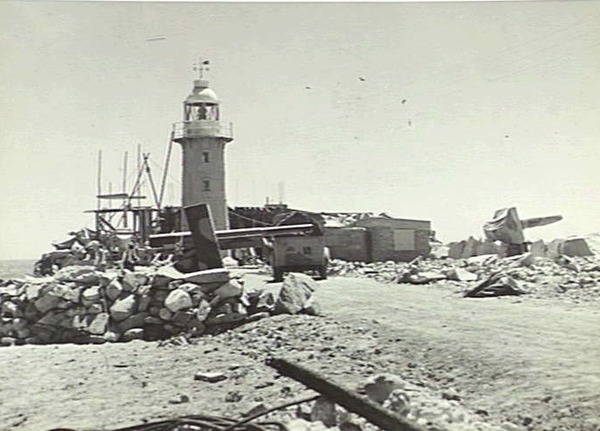Freo’s war at home
 BLACKOUTS, school closures, storefronts painted black, sandbagged or boarded, anti-submarine and anti-torpedo nets installed across the harbour entrance. Even road signs within 30km of the coast were removed as the fear of war spread to the biggest submarine base in the southern hemisphere. By early 1942, Fremantle had become a ‘Fortress’.
BLACKOUTS, school closures, storefronts painted black, sandbagged or boarded, anti-submarine and anti-torpedo nets installed across the harbour entrance. Even road signs within 30km of the coast were removed as the fear of war spread to the biggest submarine base in the southern hemisphere. By early 1942, Fremantle had become a ‘Fortress’.
The two 9.2-inch guns on Rottnest and Garden islands extended the reach of the coastal defence network more than 28km out to sea to deter any long range ships firing on the port city.
In early December when Prime Minister John Curtin announced the loss of HMAS Sydney off the coast of WA, residents called on the government to draw up evacuation plans for the strategic port now crowded with Allied ships, submarines and refugees.
The maritime tragedy on November 19, 1941 had a deep impact in Fremantle after the flagship of the Australian navy failed to return from escort duties in Sunda Strait, about 500km north of Christmas Island.
Of the 645 crew killed in action off Carnarvon, nearly 100 sailors were born in WA, many in their teens and early 20s having grown up in the port city before they enlisted and embarked for war. The names of several local Sydney ‘boys’ were posted yesterday at www.streetwisemedia.com.au following the announcement by the Federal Government the ‘Unknown Sailor’ washed up on Christmas Island after the battle was Sydney able seaman Thomas Welsby Clark, 21, of Brisbane.
 Clark’s unmarked grave was found and his remains reinterred in 2006. Two years later, Sydney searchers discovered the Australian light cruiser near the wreck of HSK Kormoran. The disguised German raider was on its way to lay mines in Shark Bay when it was spotted about 5pm as Sydney sailed south to Fremantle. Had they not met, Shark Bay and other coastal towns could have been devastated by mines laid in harbours and vital shipping lines.
Clark’s unmarked grave was found and his remains reinterred in 2006. Two years later, Sydney searchers discovered the Australian light cruiser near the wreck of HSK Kormoran. The disguised German raider was on its way to lay mines in Shark Bay when it was spotted about 5pm as Sydney sailed south to Fremantle. Had they not met, Shark Bay and other coastal towns could have been devastated by mines laid in harbours and vital shipping lines.
The close-range exchange that followed left both ships devastated. Kormoran’s crew abandoned ship about 9pm before the mine-laden raider was scuttled at midnight. Survivors later told interrogators Sydney was on fire moving slowly towards the horizon.
No trace of survivors were found except AB Clark, whose body washed up on Christmas Island in a liferaft or Carley float on February 6, 1942 (www.streetwisemedia.com.au/unknown-sydney-sailor-named-after-80-years).
Most of Kormoran’s crew (318) were rescued at sea and those who reached the coast in cramped lifeboats were taken into custody in Carnarvon and transported to Perth and Fremantle for interrogation by military authorities.
 A search was launched on November 24, auxiliaries Wyrallah, Yandra, Heros and Olive Cam having deployed from Fremantle on November 25 to join the desperate search for survivors until November 29.
A search was launched on November 24, auxiliaries Wyrallah, Yandra, Heros and Olive Cam having deployed from Fremantle on November 25 to join the desperate search for survivors until November 29.
Curtin announced the loss on November 30 as the rest of Kormoran’s crew arrived in Fremantle on Centaur with 162 POWs (including Kormoran captain Theodor Detmers), and Yandra, 72.
The first survivors of Kormoran were located three-and-a-half days after the battle, a raft of 26 men recovered by the liner Aquitania on November 23. A total of 315 Kormoran crew were recovered, including three Chinese laundrymen taken from Eurylochus sunk by Kormoran 10 months earlier.
Many of the German survivors were questioned as soon as they landed in Carnarvon and later in Perth at Swanbourne Barracks, Fremantle Detention Barracks and No.11 Internment Camp in Harvey where many Italians suspected of fascist activities were imprisoned during WW2.
Archival records show the Customs Officer in Carnarvon sent an urgent telegram to authorities after Kormoran survivors arrived on the Gascoyne coast, stating: “German prisoners of war held Carnarvon no prohibited or dutiable goods stop Naval Officer has interviewed them today stop Is any customs action necessary advise urgently prisoners have a dog and one monkey quarantine officer suggests destruction stop What forms are necessary stop”. They were put down.
By January 1942, Kormoran’s crew were moved to internment camps in Victoria where they were interrogated and their camp and belongings bugged (they also escaped for week in 1943) until their repatriation to Germany in 1947.
Two prisoners were too ill to travel and remained in Fremantle, one of whom, Erich Meyer, died of lung cancer on March 24, 1942. The only Kormoran sailor to die in Australia was buried at Karrakatta cemetery, his grave cared for by the mother of a Sydney sailor until his reinterment.
By now the Carley float carrying AB Clark’s body and possibly a second sailor had washed up on Christmas Island and their remains buried in the Old European Cemetery, just a month before Japanese forces took over the island and attacked the north of WA.
Fortress Fremantle – a WW2 target?
 ‘FREMANTLE Fortress’ stretched from Swanbourne to Cape Peron and Garden and Rottnest islands where gun batteries were installed to keep at bay enemy ships and submarines in WW2.
‘FREMANTLE Fortress’ stretched from Swanbourne to Cape Peron and Garden and Rottnest islands where gun batteries were installed to keep at bay enemy ships and submarines in WW2.
On the homefront, residents followed blackout rules and dyed curtains black and blocked out windows with black paper. Air raid shelters were built in backyards and around the city.
Families evacuated to regional areas or sent children there until the threat had subsided and schools in Fremantle were closed and students from Princess May and Fremantle Boys School sent to schools in neighbouring Bicton and Palmyra.
The sinking of HMAS Sydney off the Gascoyne Coast on its way back to Fremantle only drove home the reality of war for people already expecting the worse. The loss of 35 per cent of Australia’s naval personnel at the hands of Kormoran left Australians demoralised, and vulnerable.
With the British fighting the Nazis in Europe and the Middle East, Curtin released a statement at the end of December 1941 stating in a ‘historical watershed’: “Australia looks to America.”
 According to ‘Background Briefings – John Curtin’s War’ published in 1997 by the National Library of Australia, Curtin, “is disappointed that Churchill should have dispose of the Far East in a few sentences. His statement that Hitler cannot be beaten until 1944 meant that we would get what was left over after Europe had the choice of whatever arms were available. All this meant that Japan would keep coming against our perimeter … They could come through the Sunda Strait and could crack our new base at Exmouth. They might even make a hit-and-run raid against Fremantle. It would take them a week to come down our west coast, but it would take more than a week for assistance to come to us”.
According to ‘Background Briefings – John Curtin’s War’ published in 1997 by the National Library of Australia, Curtin, “is disappointed that Churchill should have dispose of the Far East in a few sentences. His statement that Hitler cannot be beaten until 1944 meant that we would get what was left over after Europe had the choice of whatever arms were available. All this meant that Japan would keep coming against our perimeter … They could come through the Sunda Strait and could crack our new base at Exmouth. They might even make a hit-and-run raid against Fremantle. It would take them a week to come down our west coast, but it would take more than a week for assistance to come to us”.
Add to this the threat of ‘enemy aliens’ in Fremantle and the possibility of Italian, German and Japanese forces taking over the port in the event it was overrun. By March 3, 1942, Japanese planes had bombed Broome and Wyndham.
 Fremantle was spared the same fate, but fear persisted, with regulations introduced on March 11 to remove all road signs within 20 miles of the coast. By the end of March, blackout conditions were implemented at Fremantle and Cottesloe where Curtin’s family lived.
Fremantle was spared the same fate, but fear persisted, with regulations introduced on March 11 to remove all road signs within 20 miles of the coast. By the end of March, blackout conditions were implemented at Fremantle and Cottesloe where Curtin’s family lived.
Against this anticipation, military authorities decided on March 15 to split the crowded Allied naval force in the port following the Japanese attacks on Pearl Harbour, Manila, and Surabaya, “the concentration of submarines at Fremantle created the spectre of a similar disaster”.
In his telegrams to Churchill and Roosevelt, Curtin continued until as late as March 1943 to single out Fremantle as especially vulnerable to a Japanese naval bombardment or attack by carrier-based planes.
Fremantle residents would not relax until July 1944 when WA Premier John Willcock announced, “we feel we have now averted any threat of invasion”.
Lest we forget.




